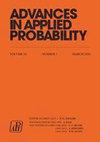Migration–contagion processes
IF 1.2
4区 数学
Q3 STATISTICS & PROBABILITY
引用次数: 0
Abstract
Consider the following migration process based on a closed network of N queues with $K_N$ customers. Each station is a $\cdot$ /M/ $\infty$ queue with service (or migration) rate $\mu$ . Upon departure, a customer is routed independently and uniformly at random to another station. In addition to migration, these customers are subject to a susceptible–infected–susceptible (SIS) dynamics. That is, customers are in one of two states: I for infected, or S for susceptible. Customers can swap their state either from I to S or from S to I only in stations. More precisely, at any station, each susceptible customer becomes infected with the instantaneous rate $\alpha Y$ if there are Y infected customers in the station, whereas each infected customer recovers and becomes susceptible with rate $\beta$ . We let N tend to infinity and assume that $\lim_{N\to \infty} K_N/N= \eta $ , where $\eta$ is a positive constant representing the customer density. The main problem of interest concerns the set of parameters of such a system for which there exists a stationary regime where the epidemic survives in the limiting system. The latter limit will be referred to as the thermodynamic limit. We use coupling and stochastic monotonicity arguments to establish key properties of the associated Markov processes, which in turn allow us to give the structure of the phase transition diagram of this thermodynamic limit with respect to $\eta$ . The analysis of the Kolmogorov equations of this SIS model reduces to that of a wave-type PDE for which we have found no explicit solution. This plain SIS model is one among several companion stochastic processes that exhibit both random migration and contagion. Two of them are discussed in the present paper as they provide variants to the plain SIS model as well as some bounds and approximations. These two variants are the departure-on-change-of-state (DOCS) model and the averaged-infection-rate (AIR) model, which both admit closed-form solutions. The AIR system is a classical mean-field model where the infection mechanism based on the actual population of infected customers is replaced by a mechanism based on some empirical average of the number of infected customers in all stations. The latter admits a product-form solution. DOCS features accelerated migration in that each change of SIS state implies an immediate departure. This model leads to another wave-type PDE that admits a closed-form solution. In this text, the main focus is on the closed stochastic networks and their limits. The open systems consisting of a single station with Poisson input are instrumental in the analysis of the thermodynamic limits and are also of independent interest. This class of SIS dynamics has incarnations in virtually all queueing networks of the literature.—迁移过程产生的外溢
考虑以下迁移过程,该过程基于具有$K_N$客户的N个队列的封闭网络。每个站点都是一个服务(或迁移)速率为$\mu$的$\cdot$ /M/ $\infty$队列。在出发时,客户被独立地、均匀地随机路由到另一个站点。除了迁移之外,这些客户还受到易受感染-易受感染(SIS)的影响。也就是说,客户处于两种状态之一:I代表受感染,S代表易感。客户可以在站点中从I切换到S或从S切换到I。更准确地说,在任何站点,如果站点中有Y个受感染的客户,则每个易感客户以瞬时速率$\alpha Y$感染,而每个受感染的客户恢复并以速率$\beta$感染。我们让N趋于无穷,并假设$\lim_{N\to \infty} K_N/N= \eta $,其中$\eta$是代表客户密度的正常数。我们感兴趣的主要问题涉及这样一个系统的一组参数,在这个系统中存在一个固定的状态,在这个状态下,流行病在极限系统中存活。后一种极限称为热力学极限。我们使用耦合和随机单调性参数来建立相关马尔可夫过程的关键属性,这反过来又允许我们给出该热力学极限相对于$\eta$的相变图的结构。对这个SIS模型的Kolmogorov方程的分析简化为我们没有找到显式解的波型偏微分方程的分析。这个简单的SIS模型是表现出随机迁移和传染的几个伴生随机过程之一。本文讨论了其中的两个,因为它们提供了普通SIS模型的变体以及一些边界和近似值。这两种变体是状态变化偏离(DOCS)模型和平均感染率(AIR)模型,它们都有封闭形式的解。AIR系统是一个经典的平均场模型,其中基于实际感染客户数量的感染机制被基于所有站点感染客户数量的经验平均值的机制所取代。后者允许产品形式的解决方案。DOCS的特点是加速迁移,因为每次更改SIS状态都意味着立即离开。该模型导致了另一种允许封闭形式解的波型PDE。在本文中,主要关注的是封闭随机网络及其限制。由泊松输入的单站组成的开放系统有助于热力学极限的分析,也具有独立的意义。这类SIS动力学在几乎所有文献中的排队网络中都有体现。
本文章由计算机程序翻译,如有差异,请以英文原文为准。
求助全文
约1分钟内获得全文
求助全文
来源期刊

Advances in Applied Probability
数学-统计学与概率论
CiteScore
2.00
自引率
0.00%
发文量
64
审稿时长
6-12 weeks
期刊介绍:
The Advances in Applied Probability has been published by the Applied Probability Trust for over four decades, and is a companion publication to the Journal of Applied Probability. It contains mathematical and scientific papers of interest to applied probabilists, with emphasis on applications in a broad spectrum of disciplines, including the biosciences, operations research, telecommunications, computer science, engineering, epidemiology, financial mathematics, the physical and social sciences, and any field where stochastic modeling is used.
A submission to Applied Probability represents a submission that may, at the Editor-in-Chief’s discretion, appear in either the Journal of Applied Probability or the Advances in Applied Probability. Typically, shorter papers appear in the Journal, with longer contributions appearing in the Advances.
 求助内容:
求助内容: 应助结果提醒方式:
应助结果提醒方式:


